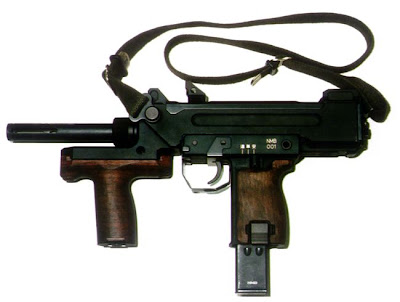Beretta M938A (Model 1938) submachine gun, left side

Beretta M938A (Model 1938) submachine gun, right side

Beretta M1938/42 (Model 1942) submachine gun

Beretta M1938/44 (Model 1944) submachine gun

Beretta M1938/49 (Model 1949 or Model 4) submachine gun

Beretta Model 2 was a folding stock version of Model 1938/49.
| | M938A | M1938/42 | M1938/49 |
| Caliber | 9x19mm Luger / Parabellum |
| Weight, empty | 4,2 kg | 3,27 kg | 3,25 kg |
| Length | 946 mm | 800 mm | 798 mm |
| Barrel length | 315 mm | 213 mm | 210 mm |
| Rate of fire | 600 rounds per minute | 550 rounds per minute | 550 rounds per minute |
| Magazine capacity | 10, 20 30, 40 rounds | 20 or 40 rounds | 20 or 40 rounds |
| Effective range | 200-250 meters | 150-200 meters | 150-200 meters |
Beretta Model 1938 submachine gun (
Mosccetto Automatic Beretta Modelo 938 in contemporary Italian nomenclature, or MAB M938 in short) was among better submachine guns of World War 2. Originally designed and manufactured to rather high standards of peace time, it served to Italian army through the earlier parts of WW2; later on, the originally complicated and expensive design was gradually simplified so guns were made lighter and significantly cheaper; nevertheless, these weapons still were effective and reliable. In post-war period, a slightly modified version of original weapon, known as Model 1938/49 or Model 4 (in post-1956 Beretta nomenclature) served with Italian army well into 1960s and 1970s. It also was widely exported, with customers of various versions including Syria, Iraq, Indonesia, Morocco, Yemen, and, at last but not at least Germany, which received M1938 submachine guns during WW2, and purchased some M1938/49 (M38/49) submachine guns in 1951 for its Border Guard (designated in post-WW2 German service as MP1). Production of M1938 series continued at least until 1962, and probably even slightly longer. Model 38/49 remained in Italian service for much longer period, probably well into 1980s.
Beretta Model 1938 submachine gun is blowback operated, selective fired weapon which fires from open bolt. Original version employed a small diameter return spring, concealed into steel tube which telescoped into the rear of the bolt. The firing pin was controlled by the lever, which pushed pin forward, toward the primer, only when bolt was going into the battery. The separate firing pin was abandoned since model 1938/42, and reduced diameter return spring and its tube guide were replaced by large diameter return spring without guide in model 1938/44. The trigger arrangements with dual triggers (front for semi-automatic fire and rear for full automatic) were similar for all modifications, although safety arrangements varied. The original MAB M1938 submachine gun had lever type safety which was located on the left side of the receiver; additional cross-bolt type control was located just behind the rear trigger; it was used to lock the rear trigger and thus limit the gun to semi-automatic fire only. Bolt handle was located on the right side of receiver and has a sliding dust cover over its slot.
When gun was cocked, shooter had to retract the handle and then return it forward, closing the slot; when gun was fired, cocking handle remained stationary. Feed was from box magazines, which were inserted from below; ejection was, rather unusually, to the left side, although the ejection port was rather far in front of the shooter's face. Stock was made from wood, with semi-pistol grip; several versions also were developed with folding shoulder stock and a separate pistol grip; there were intended mostly for parachute troops. Beretta Model 1938 submachine guns were fitted with relatively long barrels, enclosed into tubular jackets with cooling slots and large muzzle brake / compensator at the front. Since 1942, the barrels were shortened and barrel jackets omitted from design. Muzzle compensators were made in the form of several ports in the upper part of the muzzle, to reduce muzzle climb during automatic fire. Sights on original M1938 submachine guns included tangent-type rear sight, which was later replaced to simpler and less expensive flip-up type rear sight with two settings. Original M38 submachine guns also were capable of mounting a folding knife-bayonet -a feature, also dropped in later versions.
List of versions, built on basic M1938 submachine gun design, with major modifications over previous versions:
Beretta M1938/42 (M38/42): barrel jacket omitted, barrel is shortened and fluted
Beretta M1938/44 (M38/44): barrel is plain (not fluted); simplified return spring; flip-up rear sight
Beretta M1938/49 (M38/49): lever-type safety is replaced with cross-bolt safety, made in the form of large oval button, located at the middle of the stock. Overall manufacturing quality is improved over war-time production guns
Beretta Model 1: an experimental folding-stock model for paratroopers, produced in 1941; had unjacketed fluted barrel and extended magazine housing, pistol grip and under-folding metallic shoulder stock
Beretta Model 2: folding-stock model for paratroopers, produced in 1951; externally it was similar to Model 1, but it has bolt and safety of M1938/49
Beretta Model 3: a further evolution of Model 2, developed in 1955; had automated firing pin safety and telescoped buttstock made from steel wire
Beretta Model 4: same as M1938/49, but under different designation
Beretta Model 5: similar to Model 4 (M38/49), but manual safety is replaced by automated safety (safety deactivated only as long as the button on the stock is pressed by non-firing hand).








































